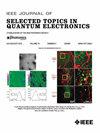用于三维片对片光子互连的单片集成光通硅波导
IF 5.1
2区 工程技术
Q1 ENGINEERING, ELECTRICAL & ELECTRONIC
IEEE Journal of Selected Topics in Quantum Electronics
Pub Date : 2025-09-26
DOI:10.1109/JSTQE.2025.3615001
引用次数: 0
摘要
电子互连的规模限制推动了对高效光学芯片到芯片链路的需求。我们报告了第一个单片集成的空气包覆光学通过硅波导在硅,制造通过博世和低温深反应蚀刻。对50 μm芯和最长150 μm传播长度的肋、单桥和双桥设计进行了评估。与波士蚀刻肋条波导(62%,−2.08 dB)相比,低温蚀刻肋条波导实现了最高的中位数传输(66%,−1.80 dB)。在所有几何形状中,3db对准窗口范围为9.3 μm至49.2 μm,采用博世蚀刻双桥波导提供最宽的公差。我们表明,在这些大芯、多模光学通硅波导中,几何保真度比侧壁粗糙度更有利于传输和对准。该技术为3D光子互连提供了一种可扩展的互补金属氧化物半导体兼容途径。本文章由计算机程序翻译,如有差异,请以英文原文为准。
Monolithically Integrated Optical Through-Silicon Waveguides for 3D Chip-to-Chip Photonic Interconnects
The scaling limitations of electrical interconnects are driving the demand for efficient optical chip-to-chip links. We report the first monolithic integration of air-clad optical through-silicon waveguides in silicon, fabricated via Bosch and cryogenic deep reactive-ion etching. Rib, single-bridge, and double-bridge designs with 50 μm cores and up to 150 μm propagation lengths have been evaluated. Cryogenic-etched rib waveguides achieve the highest median transmission (66%, −1.80 dB), compared to Bosch-etched ribs (62%, −2.08 dB). Across all geometries, 3 dB alignment windows range from 9.3 μm to 49.2 μm, with Bosch-etched double-bridge waveguides providing the broadest tolerance. We show that geometric fidelity outweighs sidewall roughness for transmission and alignment in these large-core, multimode optical through-silicon waveguides. This technology provides a scalable, complementary metal-oxide semiconductor-compatible pathway toward 3D photonic interconnects.
求助全文
通过发布文献求助,成功后即可免费获取论文全文。
去求助
来源期刊

IEEE Journal of Selected Topics in Quantum Electronics
工程技术-工程:电子与电气
CiteScore
10.60
自引率
2.00%
发文量
212
审稿时长
3 months
期刊介绍:
Papers published in the IEEE Journal of Selected Topics in Quantum Electronics fall within the broad field of science and technology of quantum electronics of a device, subsystem, or system-oriented nature. Each issue is devoted to a specific topic within this broad spectrum. Announcements of the topical areas planned for future issues, along with deadlines for receipt of manuscripts, are published in this Journal and in the IEEE Journal of Quantum Electronics. Generally, the scope of manuscripts appropriate to this Journal is the same as that for the IEEE Journal of Quantum Electronics. Manuscripts are published that report original theoretical and/or experimental research results that advance the scientific and technological base of quantum electronics devices, systems, or applications. The Journal is dedicated toward publishing research results that advance the state of the art or add to the understanding of the generation, amplification, modulation, detection, waveguiding, or propagation characteristics of coherent electromagnetic radiation having sub-millimeter and shorter wavelengths. In order to be suitable for publication in this Journal, the content of manuscripts concerned with subject-related research must have a potential impact on advancing the technological base of quantum electronic devices, systems, and/or applications. Potential authors of subject-related research have the responsibility of pointing out this potential impact. System-oriented manuscripts must be concerned with systems that perform a function previously unavailable or that outperform previously established systems that did not use quantum electronic components or concepts. Tutorial and review papers are by invitation only.
 求助内容:
求助内容: 应助结果提醒方式:
应助结果提醒方式:


